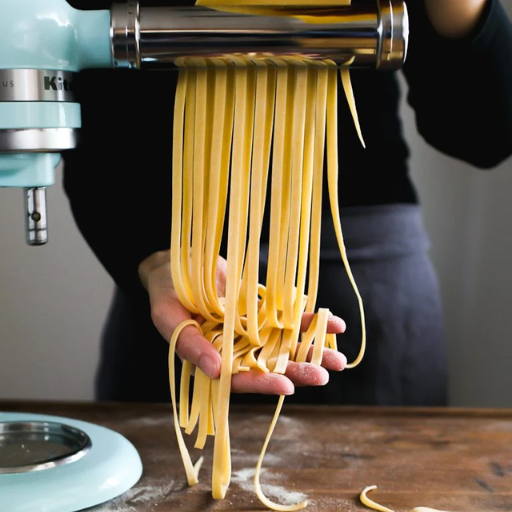If you’re as big a pasta fan as us, then we have something for you. Making fresh pasta at home is a game changer – it’s not just the taste; homemade pasta has a texture and lightness that shop-bought can never match. So, we’ve put together this guide to the five best pasta makers of 2024. We know some people will be new to cooking or just starting with making their food – but don’t worry! We’ve chosen these machines carefully so they’ll work well no matter what level or budget (within reason) someone might have. Keep reading to know which will help make perfect spaghetti, fettuccine, or ravioli plates.
What Should You Look for in a Pasta Maker?
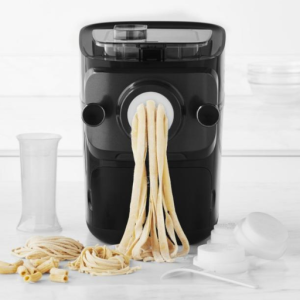
Image source: https://www.foodnetwork.com/
When you’re selecting a pasta machine, these main points should be taken into consideration:
- Type: Choose between manual or electric models depending on the comfort and convenience desired.
- Material: Seek long-lasting materials such as stainless steel, making cleaning easier.
- Flexibility: See whether or not this thing can make different shapes or sizes of noodles–some might call it versatile in terms of noodle-making potentialities if one were so inclined.
- Ease of Use: Make sure this device is beginner-friendly since some may not have any experience handling them.
-
Price: Consider what features each offers against their cost so you can get more bang for your buck.
Understanding Different Types of Pasta Makers
Regarding pasta makers, there are two main types: manual and electric.
Manual Pasta Makers
Manual pasta makers, or hand cranks, require you to feed the dough through the rollers by turning a handle. These machines usually have adjustable settings to control the thickness of the pasta and may come with attachments for different shapes. The cost of manual models is generally lower than their electric counterparts, and they offer more control over the process. They’re great for people who like making pasta in the old-fashioned way and are involved in every step of production.
Electric Pasta Makers
Electric pasta makers do all the rolling and cutting automatically, saving time and effort. These are best suited to those who want convenience or have limited physical capabilities or strength. They can often make various shapes or thicknesses more efficiently than manual ones; some premium models even mix/knead dough from scratch till the finished product is hands-free! This type is perfect for individuals who frequently make pasta dishes that require uniformity in texture throughout every bite served on different occasions, e.g., in restaurants.
Knowing what distinguishes one type of machine from another will help you choose better based on your space constraints and goals when preparing meals involving noodles such as these.
Manual vs. Electric: Which is the Best Pasta Maker?
When considering a pasta maker, one’s choice between manual and electric appliances dramatically depends on personal preferences and needs.
Manual pasta makers are often well-received because they are simple and allow more hands-on control. They are cheaper than their automatic counterparts and offer more excellent options for thicknesses or shapes that can be produced.
However, electric-powered models excel at convenience and productivity. These machines are perfect for those who want to save time because they do most things automatically. More expensive units can even mix and knead the dough, thus ensuring consistent results, which is very important to people who make pasta frequently and need it done fast without much effort.
Therefore, the ideal machine for you will depend on how much you would love doing things yourself compared to the convenience and speed it requires. If artisanal feel and tolerability are your utmost concerns while making pasta, go with a hand-driven machine. Still, an automatic device would be better suited for such tasks if efficiency mattered most.
Attachments and Accessories: Essential for Perfect Homemade Pasta
Attachments and supplements can make your pasta-making experience ten times better and allow you to make more shapes and types of pasta. This is a list of the most important ones:
- Shapes and cutters: Clever attachments allow the production of different types of pasta, such as spaghetti, fettuccine, or ravioli, with ease. These little gadgets enable you to change between various shapes without getting another whole machine.
- Pasta drying rack: A drying rack keeps your pasta in shape and texture. It ensures even drying, which prevents them from sticking together.
- Kneading/mixing accessories: If you own an electric pasta maker, kneading/mixing accessories could save you quite some time. They prepare the initial dough automatically, thus ensuring consistent, well-kneaded dough every time.
These are just a few attachments that one can invest in. Buying them will give you more options when making pasta, not to mention efficiency, hence the ability to come up with different kinds efficiently and accurately too.
Which Are the Best Pasta Makers of 2024?
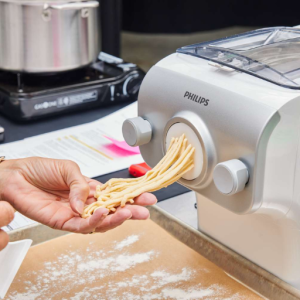
While assessing the top pasta makers of 2024, several models are notable for their performance, ease of use, and versatility:
- Philips Pasta and Noodle Maker Plus: This electric machine is fast and efficient. It mixes, kneads, and extrudes pasta in minutes. It has an intuitive interface that users love and comes with various shaping discs.
- Marcato Atlas 150: A manual pasta maker known for its durability and precision. Numerous attachments can be used to make different types of pasta with this machine, making it perfect for those who prefer traditional methods.
- Imperia Pasta Maker Machine: This excellent manual option stands out because of its solid construction and high-quality rollers, which produce smooth, even sheets of pasta every time. Additionally, it has various cutter attachments, providing more options when needed.
- KitchenAid Pasta Attachment Set: Designed for those who already own a KitchenAid stand mixer, this attachment set takes the hard work out of making homemade pasta while delivering consistent results—easy peasy!
- Hamilton Beach Electric Pasta Maker: This electric model is ideal if you’re looking for something affordable. It’s simple to use and can produce many shapes without much effort.
All these machines have strengths, so there’s one to suit any requirement, from a low-tech artisanal approach to mass production using state-of-the-art technology.
Top Picks: Best Manual Pasta Maker Models
When people think about manual pasta makers, some products consistently get good reviews on popular review sites for being practical, tough, and user-friendly.
- Marcato Atlas 150:
- The Marcato Atlas 150 has been repeatedly praised for its durability, strength, and quality. Its ten-position adjustment dial allows you to change pasta thickness easily, meaning options are limitless. Also, you can quickly add additional cutters so that various types of pasta may be produced—an excellent multi-purpose tool for any enthusiast.
- Imperia Pasta Maker Machine:
- This machine is loved by many due to its made-in-Italy status and being made entirely out of heavy-duty chrome-plated steel. The steel ensures that each sheet rolls out smoothly every time, ensuring even cooking throughout your dish while preventing tears from forming should the dough be thin enough. It’s also fitted with a dual cutter head attachment, which means changing between fettuccine and spaghetti (and other similar combinations) is simple – perfect if you have different preferences regarding pasta type!
- OxGord Hand Crank Pasta Maker:
- Affordable simplicity might be one way to describe this product best, but don’t let lower prices fool anyone into thinking they’re compromising on performance here! This crank isn’t just cheap. It’s cheerful too: there are dough thickness settings for those who like theirs, thin or thick alike; plus, cutters come with different shapes, such as lasagna sheets, so versatility won’t become an issue either way around when using this device at home. Assembling and cleaning up afterward shouldn’t pose many difficulties, considering how straightforward everything else seems during the operation – another reason why beginners love it.
With sturdiness and accuracy like those offered by the Marcato Atlas 150, together with affordability and practicality found in the OxGord Hand Crank Pasta Maker, no one could ever say these brands fail to cater to various levels of experience in pasta making.
Special Features to Look for in the Best Pasta Makers of 2024
When looking for the finest pasta maker of 2024, there are several essential points to consider to find the suitable model for you:
- Material and construction quality: Look for a pasta maker with solid materials like stainless steel or heavy-duty plastics. This will ensure it lasts, remains stable during use, and performs robustly.
- Adjustable Thickness Settings: Look for machines with many levels of thickness adjustment. This allows you to make different styles and thicknesses of pasta, from thin angel hair to thick lasagna sheets.
- Ease of Use and Cleaning: The best pasta makers are easily understood by users through simple assembling or disassembling steps. They should also have parts that detach easily for dishwasher-safe cleaning convenience.
- Motor Power (Electric Models): For electric models, check how much power their motors have and what speeds they can attain. Those with higher wattage ratings may be able to produce more output consistently, while multiple speed options could enhance efficiency.
- Safety Features: Good safety features include non-slip feet on the base so that it doesn’t slide off the countertop while being used, an auto-shutdown function in case it overheats, and a finger guard, among others.
- Included Accessories and Attachments: Ensure that various cutting heads are provided with other attachments for different shapes(e.g., spaghetti, fettuccine, ravioli).
- Brand Reputation and Reviews: Always go through brands established as reliable producers of high-quality products within this industry segment. Also, try reading customer feedback shared after using these items to hint at what could be expected during actual usage scenarios.
Considering all these factors while deciding will enable you to buy an appliance that will continue to meet your cooking needs.
How to Make Fresh Pasta with a Pasta Machine?
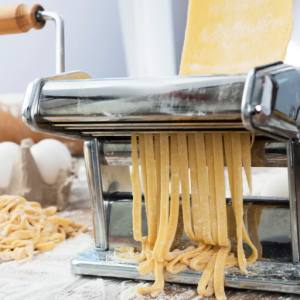
Follow these simple steps to make fresh pasta using a pasta machine:
- Prepare the Dough: Mix 2 cups of all-purpose flour, three large eggs, and a pinch of salt. When the dough forms, knead it on a floured surface for about ten minutes until it becomes smooth and elastic. If the dough seems too dry, add one teaspoon of water until you reach the right consistency. Wrap this mixture in plastic wrap and let sit for half an hour.
- Divide and Flatten: Slice the rested dough into four equal pieces before flattening any single portion with a rolling pin so that its thickness matches that which can go through the widest setting chosen on your pasta machine. To avoid drying out, keep other parts covered.
- Rolling Out The Dough: Feed the flattened dough through rollers by setting them at their widest point or opening on a pasta machine. To achieve the required width, gradually decrease the space between two rolls by folding the dough in half before each pass while narrowing down the settings used.
- Cutting Pasta: When the dough reaches the desired thinness, use the cutting attachment. This usually creates fettuccine or spaghetti shapes, but there are many different types available.
- Cook Pasta: Boil salted water in a pot. Freshly made pasta cooks very quickly compared with dried ones, so they should be watched closely after being added to boiling water for two to five minutes or cooked until al dente.
- Serve It Warm: Drain off excess moisture from boiled noodles, then mix them either with your favorite sauce recipe already prepared beforehand or according to personal taste preference if you follow any specific dish idea found online, etcetera.
Enjoy your homemade fresh pasta!
Step-by-Step Guide to Using a Pasta Maker
Using a pasta machine can seem intimidating, but you can make excellent homemade pasta in just a few simple steps.
- Prepare Your Pasta Maker: Fasten the pasta maker to a clean, flat surface so it won’t move around while you work. Ensure that all the parts of your device are clean and dry.
- Make Your Dough: Begin with a well-rested dough from flour and eggs. Divide this into small enough portions to pass through the widest setting on your machine.
- Feed it Through and Fold: Start by running the dough through the thickest setting on your machine. Fold it in half, then pass it through again. Repeat several times until you have an even consistency throughout — each pass will help develop gluten and create elasticity in the final product.
- Thinning Gradually: Adjusting settings between rolls, work your way down to progressively thinner widths until reaching the desired thinness (typically, this means one or two passes at each setting). This is where different pasta types start coming together!
- Cutting It Up: With the sheet now at the desired thinness, swap out the roller for a cutter attachment that corresponds with the desired noodle shape; feed the dough through the cutter to get even strips.
- Dry or Cook: If not boiling immediately, air-dry fresh noodles using a rack or floured surface to prevent sticking. Fresh pasta cooks fast—boil salted water, drop in noodles, and cook 2-4 minutes until al dente.
- Serve and Enjoy: Serve with sauce as preferred or use when preparing a favorite meal; otherwise.
Follow these simple steps, and soon, you’ll be cranking out professional-grade fresh pasta by the dozen. As you continue honing your craft, don’t hesitate to experiment with different shapes and flavors!
Pro Tips for Perfect Pasta Dough
- Utilize Premium Ingredients: Choose ‘00’ flour, famous for its fine grain and perfect gluten content. This makes the dough smooth and elastic when worked. Fresh organic eggs can achieve richness in color and flavor.
- Keep the Consistency of the Dough Right: The dough should be soft, silky, and slightly tacky but not sticky. If it feels too wet, add some more flour. If it feels too dry, sprinkle small amounts of water at a time, say teaspoonfuls, until right.
- Rest the Dough: Let the dough rest for half an hour, at least after kneading it under a damp cloth or plastic wrap. This stage helps relax gluten so that rolling becomes easier, resulting in tender pasta.
- Knead Properly: Kneading well develops gluten, thereby giving the desired elasticity. You should do this for around 10 minutes until you get a smooth one that springs back when poked.
- Temperature is Key: Work in fantastic surroundings if possible because heat will make your mixture sticky and hard to handle. Also, keeping it in the fridge briefly can help improve its texture.
- Deal with Unevenness: If cracks develop on your sheet during rolling, spray some water lightly onto the affected area and let it sit for a while before continuing. This ensures even sheets without breaks.
If you follow these tips from experts who know what they are discussing, your pasta will come out ideally every time. So don’t just cook homemade noodles—make them!
Recipes to Try: From Spaghetti to Ravioli
Classic Spaghetti Carbonara
Ingredients:
- 200g spaghetti
- 100g pancetta
- Two large eggs
- 50g Pecorino cheese, grated
- 50g Parmesan cheese, grated
- Two plump garlic cloves peeled and left whole
- 50g unsalted butter
- Sea salt and freshly ground black pepper
Instructions:
- Boil salted water in a large pot and cook spaghetti until done.
- Whisk eggs in another bowl, then mix with Pecorino and Parmesan cheese.
- Crisp the pancetta with garlic cloves in butter; take out the garlic.
- Combine pasta with pancetta and garlic-infused butter.
- Take the pan off heat; pour the egg and cheese mixture into it quickly, stirring to form a creamy sauce.
- Season with salt and pepper to taste. Serve immediately.
Fresh Spinach and Ricotta Ravioli
Ingredients:
- Fresh pasta dough (see above for tips)
- 250g fresh spinach, chopped
- 250g ricotta cheese
- One egg yolk
- 50g Parmesan cheese, grated
- Pinch of nutmeg
- Salt and pepper to taste
- Tomato sauce or sage butter for serving
Instructions:
- Saute spinach over medium-high heat until it wilts. Drain; chop finely.
- Combine spinach, ricotta, yolk, Parmesan cheese, nutmeg, salt, and pepper in a bowl.
- Roll out pasta dough into thin sheets. Place small amounts of filling on one sheet.
- Cover with another sheet of pasta; press around the filling to seal. Cut into individual ravioli pieces.
- Cook ravioli in boiling salted water until they float to the top – around 3-4 minutes.
- Serve topped with sage butter or simple tomato sauce.
Fettuccine Alfredo
Ingredients:
- 200g fettuccine
- 100g unsalted butter
- 250ml heavy cream
- 100g Parmesan cheese, grated
- Salt and freshly ground black pepper
- Fresh parsley, chopped, for garnish
Instructions:
- Cook fettuccine according to package directions; drain well when finished.
- Melt butter in a saucepan over medium heat; stir in cream gradually.
- Simmer for a few minutes until slightly thickened.
- Add Parmesan cheese while stirring continuously until melted through smooth sauce consistency achieved.
- Toss fettuccini noodles together with Alfredo sauce till fully coated.
-
Season dish using black pepper & ground sea salt; garnish chopped parsley before serving hot.
How Do You Maintain and Clean a Pasta Machine?
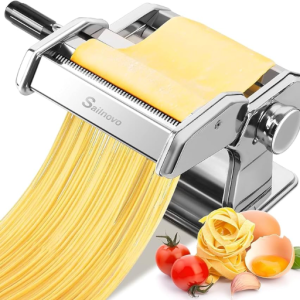
A pasta machine should be maintained and cleaned to ensure it lasts long and works well. Use a gentle brush or wooden stick to remove any dough left in the machine – water will only cause rusting. If possible, dismantle it and clean each part thoroughly. For dried pasta residue, just wipe it off with a soft, dry cloth. Apply mineral oil on cutting rollers and gears regularly so they do not dry out or fail to move smoothly. Keep the device in a dry place under cover to prevent dust from settling on it due to humidity. Regular maintenance will ensure you enjoy many more years of using your pasta maker.
Simple Steps for Cleaning a Manual Pasta Maker
- Disassemble: Take apart your manual pasta maker, removing all detachable parts. This will allow you to clean each component more thoroughly.
- Brush Off Residues: Use a small soft brush to remove any remaining flour or dough pieces. You can also use a wooden skewer or toothpick to remove any stubborn dough stuck in the rollers or cutters.
- Wipe Down Rollers and Cutters: Slightly moisten a cloth with water and wring it well; then, wipe off the surfaces of the rollers and cutters. Never put water on the pasta maker, as this may cause rusting.
- Use Compressed Air: For areas that are hard to reach, you may use compressed air to blow away any leftover flour or dough particles.
- Dry Thoroughly: Ensure all portions are arid before assembling the pasta machine again. If moisture is allowed to contact it for long periods, it may cause the metals used to rust and damage other parts.
- Lubricate Moving Parts: Apply a few drops of food-grade mineral oil to moving points to keep working smoothly together without sticking up against one another, causing friction. This friction eventually damages them permanently, making them inefficient forever.
- Store Correctly: After cleaning, store in a cool, dry place, if possible, where there isn’t much humidity. Then, cover up using the original box or even wrap it with a cloth lest dust gather around it, thereby reducing its effectiveness due to blockage by dirt over time.
Following these steps will ensure that your manual pasta maker stays functional for years to come and serves you reliably when needed in the kitchen.
Maintenance Tips for an Electric Pasta Maker
- Disconnect Before Cleaning: Unplug the electric pasta maker from the socket before cleaning or servicing it.
- Take Apart Components: Disassemble all detachable parts of the machine, such as rollers, cutters, trays, etc. Each model may have different pieces; therefore, consult the user manual for instructions on dismantling them correctly.
- Clear Dough Residues: Remove excess dough or flour from the device using a dry cloth or brush. Do not put water near any electric part of it.
- Clean Surfaces: Dampen a soft cloth slightly and gently wipe over non-electric surfaces like roller bars and cutting blades. Avoid soaking these areas, as they can easily hold moisture.
- Utilize an Air Blower Can: To remove invisible particles of dough and flour from corners and narrow spaces without wetting them, use a burst of air from a compressed air canister.
- Dry Off All Parts Completely: Ensure that every component is completely dried off before assembling your pasta-making machine; this is important to prevent rusting, which will shorten its life span.
- Oil Moving Parts: Put some drops of food-grade oil onto the areas indicated in the user’s guide where movement occurs frequently to ensure smooth operation.
-
Keep Safe When Not In Use: Store electric pasta makers in cool, dry areas, preferably in their original boxes, or wrap them in a clean, dry cloth to protect against dust accumulation.
These hints for care will keep an electric pasta-making machine at its best performance, meaning that you can enjoy homemade fresh pasta for many meals ahead.
Preventing Rust and Extending the Life of Your Pasta Machine
To keep rust from forming and to make your pasta machine last longer, do the following:
- Dry It Off: Before putting away your pasta machine, be sure it is scorched. Use a clean cloth to remove any remaining wetness, particularly on metal surfaces.
- Clean Regularly: After using the machine each time, brush off any dough or flour particles. Don’t use water because it can speed up rusting; employ a dry cloth or brush instead.
- Use Food-Grade Lubricants: Apply small amounts of food-grade lubricant to the moving parts now and then. This will help prevent metal corrosion and ensure smooth operation of the components.
- No Damp Storage: Keep this equipment in cool, dry places always. If there’s a lot of humidity in your kitchen, store it in cupboards or pantries where moisture won’t reach at all costs.
- Cover Up Unused Times: Make sure to cover up with either cloth/plastic covers whenever not being used so that dust doesn’t accumulate on them due to airborne moisture.
With these steps taken beforehand, one can ensure that their pasta machine stays in great shape for many more years because no rust will appear on its parts, thus remaining functional.
Top Brands to Consider When Buying a Pasta Maker
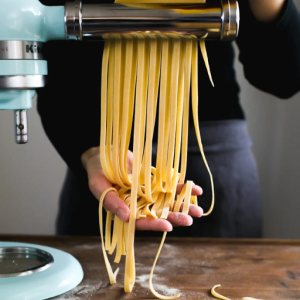
When it comes to buying a pasta-making machine, some of the top brands known for their quality and dependability are as follows:
- Marcato: The Marcato Atlas is pasta lovers’ favorite pasta maker. It is famous for its strength and ease of use. This brand has many models made in Italy that cater to beginners and seasoned cooks.
- Imperia is another Italian brand recognized worldwide for its robust build and smooth mechanics. If you prefer a classic approach to kitchen appliances, then the Imperia Pasta Machine will be perfect for your needs.
- Philips: For those who want an electric pasta maker, Philips has models with user-friendly features that can mix, knead, and extrude pasta dough effortlessly; these machines save time without compromising quality.
- KitchenAid provides attachments for its stand mixers so people can easily make homemade noodles at home. Kitchen Aid Mixers also serve other functions, like mixing dough and batter. Therefore, purchasing this attachment would expand its functionality further if someone already owns one such device.
- CucinaPro: Cucina Pro offers affordable yet reliable options—a great choice if you are on a budget and still want something durable to last longer than a few months. These products are generally simple in design, so they should not cause too much trouble even for beginners, thus making them quite popular among such users.
Each brand offers different types of machines depending upon individual requirements, ensuring that anyone who loves eating homemade spaghetti can find just what they need to prepare delicious dishes from scratch.
Reviews: Marcato Atlas 150 vs. Imperia
When you compare the Marcato Atlas 150 with the Imperia pasta maker, user reviews reveal a few things.
Build Quality and Design: Both machines’ build quality is outstanding; they are made of chrome-plated steel, which makes them durable. That being said, many people compliment the sleek, modern look and small size of the Atlas 150 more, as well as its slightly lighter weight than that of the Imperia.
Ease of Use: Nothing is easier than these two devices for many users. However, according to some customers’ feedback left online, one may need to put more effort into working with thick dough using an Imperia machine. At the same time, the Marcato Atlas 150 has a smooth, easy-to-turn crank, which gives it an advantage over others in terms of user-friendliness.
Versatility: This feature makes this pasta-making device unique. With additional attachments, one can make any kind besides noodles or sheets, as with most competitors’ products. Meanwhile, simplicity and effectiveness are what people love about Imperias, but there aren’t many attachments readily available for them compared to Atlasses.
Price: A Marcato Atlas 150 typically costs more than an Imperia, though most buyers believe the extra features and better finish deserve such a price difference.
Final Verdict: Both machines enjoy wide popularity among users, often giving them the highest performance marks. Nevertheless, if versatility and ease of use matter more, I recommend buying the Maratono Atlas 150 over any other model mentioned here. Those who prefer traditional craftsmanship and a slight cost reduction should go for Imperias.
Why KitchenAid Pasta Attachments Are So Popular
The fact that KitchenAid pasta attachments have a robust design, are easy to use, and work well with the stand mixer explains their popularity. These attachments are made of high-quality stainless steel, which is why they last long, too. The hands-free operation feature allows users to feed and catch pasta without using their hands, thus simplifying the process. Moreover, different types of pasta can be produced uniformly thanks to this multi-purpose tool, improving the overall experience of making pasta. It is, therefore, not surprising that many people who love cooking or eating pasta at home love these attachments because, apart from being durable, they also offer convenience through simplicity alongside flexibility in usage.
Comparing Popular Pasta Roller Attachments
According to users, the KitchenAid 3-Piece Pasta Roller & Cutter Set, the Marcato Atlas 150 Pasta Roller, and the Imperia Pasta Maker are usually the best pasta roller attachments.
KitchenAid 3-Piece Pasta Roller and Cutter Set: This attachment set is designed to fit perfectly with a KitchenAid stand mixer, meaning making pasta takes no effort or time. It consists of a roller, fettuccine, and spaghetti cutters made from high-quality stainless steel. People say that it always works well, is easy to clean, and saves their time because it’s motorized.
Marcato Atlas 150 Pasta Roller: The Atlas 150 is an Italian device known for its excellent build quality. It is operated manually and has ten thickness settings adjustable to the user’s needs, thus providing complete control over pasta thickness. Many like its durability and classic design; additional attachments allow for making different types of pasta, making this machine multifunctional.
Imperia Pasta Maker: This machine doesn’t require any energy source either since everything is done by hand; besides, it has the typical robust construction inherent in Italian equipment’s traditionality. There are two cutters for fettuccine/spaghetti here. People mention its reliability and robustness while having fewer options than those provided by the Atlas 150—nevertheless, beginners love such simplicity combined with a low price.
So, basically, we have the following: convenience and speediness (due to motors) represented by the KitchenAid set; variability accuracy ensured through Marcato Atlas 150; and affordability traditionalism embodied in Imperia.
Frequently Asked Questions (FAQs)
Q: What are the top-rated pasta makers to buy in 2024?
A: The top-rated pasta makers for 2024 include the Marcato Atlas 150 Pasta Machine, Imperia Pasta Maker Machine, best electric pasta makers, and pasta maker attachments for KitchenAid. These machines are highly recommended for their durability and ease of use.
Q: How does the Marcato Atlas 150 Pasta Machine compare to other pasta makers?
A: The Marcato Atlas 150 Pasta Machine is renowned for its superior build quality and versatility. Compared to other pasta machines, it offers a broader range of pasta types, including stuffed pasta and pasta strands. It’s an excellent choice for both beginners and experienced cooks.
Q: Is an electric pasta maker better than a manual one?
A: Electric pasta makers, such as the best electric models, offer the convenience of automation and quicker pasta production. On the other hand, manual pasta machines like the Atlas 150 Pasta Machine give you more control over the pasta texture and are often more affordable.
Q: Can I use a pasta maker attachment for my Kitchenaid stand mixer?
A: Specific pasta maker attachments are available for KitchenAid stand mixers. These attachments can transform your stand mixer into a versatile pasta and noodle maker, allowing you to make various pasta dishes comfortably at home.
Q: What features should I look for in a pasta maker machine?
A: When choosing a pasta maker machine, look for features like adjustable thickness settings, ease of cleaning, and durability. Machines like the Marcato Atlas 150 Pasta Machine and the Imperia Pasta Maker Machine are known for these qualities. Additionally, consider whether you need a manual or electric model based on your preferences.
Q: How do I use a pasta maker to make fresh pasta at home?
A: To make fresh pasta at home, start with a simple pasta recipe: combine flour and eggs, knead the dough, and let it rest. Use your pasta maker machine to roll and cut the dough into your desired pasta shapes, such as pasta strands or filled pasta. Follow the machine’s instructions for the best results.
Q: Can pasta maker attachments help me make different pasta shapes?
A: There are specialized pasta maker attachments, such as the gourmet pasta press attachment and the ReThone pasta maker attachment. These attachments allow you to create various pasta shapes, enriching your homemade dishes.
Q: Has anyone tested the pasta makers reviewed?
A: Yes, all recommended pasta makers have been tested for performance, ease of use, and durability. Reviews and tests confirm that machines like the Marcato Atlas 150 Pasta Machine and Imperia Pasta Maker Machine are among the best to buy in 2024.
Q: How do I clean my pasta maker machine?
A: First, remove any excess dough with a soft brush or wooden skewer to clean your pasta maker machine. Avoid using water or soap, as this can damage the machine. Instead, wipe it down with a dry cloth. Refer to the machine’s manual for specific cleaning instructions.
Q: Can I make pasta with these machines like a professional at home?
A: Absolutely! You can produce high-quality pasta like a professional with top-rated pasta makers like the Marcato Atlas 150 Pasta Machine and appropriate pasta maker attachments. Experiment with fresh pasta recipes to refine your technique and enjoy delicious homemade pasta dishes.












